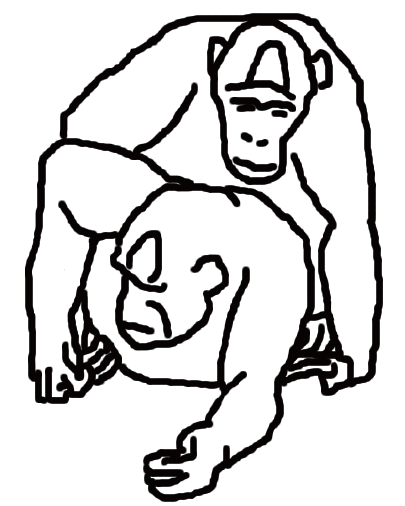|
<NOTE>
Homosexual Interactions among Young Female Wild Chimpanzees: An Example of Social Pretend Play?
Masaki Shimada
Teikyo University of Science, Japan INTRODUCTION Homosexual behavior among animals is ethologically defined as a display of courtship that involves mounting and/or genital contact and stimulation between samesex individuals (Vasey & Sommer 2006, p10). Several studies have examined homosexual behaviors between two females of the genus Pan. Wild female bonobos (P. paniscus) frequently engage in homosexual interactions such as genito-genital rubbing (GG-rubbing; e.g., Fruth & Hohmann 2006). Conversely, wild female chimpanzees (P. troglodytes) rarely engage in homosexual interactions (Zamma & Fujita 2004), even though young captive female chimpanzees in a group engaged in GG-rubbing as frequently as did wild bonobos (Anestis 2004). During homosexual interactions, it has been observed that most wild female bonobos rub their genital regions on a lateral axis in the ventroventral position, and rarely engage in pelvic thrusts (Fruth & Hohmann 2006). Captive female chimpanzees, in contrast, rub their genital regions on a front-back axis in the dorsoventral position (Anestis 2004). Homosexual interactions between female bonobos frequently occur during feeding, when group excitement is high (Fruth & Hohmann 2006). In captive chimpanzees, however, most interactions occur during group rest periods (Anestis 2004). Only one previously observed case of homosexual interaction between chimpanzee females of the Mahale M group occurred during a relaxed situation (Zamma & Fujita 2004). Several hypotheses have been proposed and tested regarding the function of homosexual behavior between Pan females (Anestis 2004; Fruth & Hohmann 2006). However, in other animal species, such as American bison (Bison bison) (Vervaecke & Roden 2006) or cervid species (Bartoš & Holečková 2006), some homosexual interactions between young females were interpreted as social play or biologically functionless byproducts of adaptations (Vasey & Sommer 2006). Although Anestis (2004, p481) reported that one captive female chimpanzee vocalized play-panting with play-face during a homosexual interaction, researchers have not discussed the possibility that homosexual interactions between wild Pan females are a pattern of social play. In this article, I describe an observed case of homosexual interaction between wild female chimpanzees, and discuss the property of the interaction as social pretend play (Bjorklund & Pellegrini 2002). METHODS Well-habituated wild chimpanzees of the M group in Mahale Mountains National Park, Tanzania were studied from December 2013 to January 2014 (nine observation days and 60.2 observation hours in total) (see Nishida 2012 for details of the research site). I use italics to emphasize likely homosexual interactions. The number and symbol in parentheses after each individual’s name represents his/her age and sex, respectively. OBSERVATION On January 3, 2014, at 13:47, I found XP (13♀), without signs of estrous, together with her infant daughter XP12 (1♀), and began to follow her. At 14:32, XP encountered a party consisting of four adult males (CT, AL, OR, and DW), an old female WX, and an adolescent female EJ (estimated 10♀). EJ showed minimal sexual swelling, exclusively in her perineal area. Most party members calmly engaged in grooming. At 14:32:33, XP approached CT, and they kissed each other with open mouths. Then XP turned to EJ, embraced, and kissed her with an open mouth. At 14:33:23, EJ presented her genital region to XP with a crouching posture on the ground. Sitting behind EJ, XP began to thrust her hips back and forth toward the genital region of EJ, and continued thrusting until 14:34:01 (Figure 1; see also Video 1: available online at mahale.main.jp/ PAN/21_1/21(1)_03.html). During the mounting, XP’s clitoris, or her genital region, faced toward the outside of the area between XP’s hip and EJ’s hip. Their facial expressions were not visible from my vantage point (Figure 1). No clear vocalization accompanied the interaction. At 14:34:08, they investigated each other’s genital regions. EJ expressed play-face and XP reached out her arm in order to grasp EJ’s arm. At 14:34:22, XP and EJ kissed with open mouths, and then began wrestling and tickling each other. They continued playing until 14:35:08. 
Figure 1. XP (left) is mounting EJ (right) dorsoventrally during the first bout (image traced from video footage). Video 1. At 14:36:49, XP approached the grooming males. AL first groomed XP, and then XP was groomed by AL, while EJ groomed WX next to XP. XP stopped grooming at 14:37:03, and started tickling XP12 with DW. EJ stopped grooming at 14:38:00, and approached XP. At 14:38:52, XP stopped tickling XP12. EJ presented her genital region to XP in a crouching posture on the ground at 14:39:03, and XP touched EJ’s genital region with her right hand. She then sat and mounted EJ at 14:39:06, and thrust her hips subtly until 14:39:09 (Figure 2). Then, XP began grooming EJ’s back. After XP stopped grooming at 14:39:16, EJ walked away and started grooming WX. DW and XP began tickling each other, and they continued in social play with XP12 until 14:44:30. I observed XP until I lost her at 15:06, and then I observed EJ until 16:00. Neither of them mated with any males. 
Figure 2. XP (back) is mounting EJ (front) dorsoventrally during the second bout (image traced from video footage). I asked several Mahale researchers whether they had observed similar interactions under similar circumstances. No researchers had made such observations previously. DISCUSSION This observation included two homosexual bouts, which lasted for 38 and 3 seconds, respectively. EJ’s presenting, and XP’s mounting that followed, were homosexual behaviors according to Vasey & Sommer’s (2006) definition, even if their genital regions did not make contact. According to Burghardt (2005), activities are recognized as play behaviors when they fulfill the following five criteria: (1) incompletely functional, (2) voluntary, (3) different structurally or temporally from the related serious behavior system, (4) expressed repeatedly, and (5) initiated in benign situations. The case reported here appears to fulfill these criteria. (1′) The direct function of the observed homosexual interaction is unclear, even though some hypotheses have been suggested to explain the biological function of homosexual interactions between female bonobos (Fruth & Hohmann 2006). In addition, if the behavior had a direct function—which is unlikely—many other individuals certainly would have performed the behavior. (2′) EJ presented her genital region to XP, and XP mounted EJ independent of any external factors, as the interactions were observed in rather calm situation. (3′) The ethological pattern of the interactions was different from heterosexual interactions. For example, the first case lasted substantially longer (38 seconds) than typical heterosexual copulations, which last for an average of 7.1 seconds (range 2–13) in the wild (Nishida 1997), and 6.7 seconds (range 1–30) in captivity (Anestis 2004). (4′) Two bouts of homosexual interactions were observed; thus, the behavior might have been repetitive, at least between XP and EJ. (5′) Because these two bouts were performed directly after encountering and kissing each other, and socially playing or grooming, respectively, their contexts were considered calm and benign. Considering these five factors, it is reasonable to regard the homosexual interaction between XP and EJ as a pattern of social play, even though they did not demonstrate clear signs of play, such as play-face or playpant. This interpretation is not contradictory to the fact that they began tickling and wrestling play directly after these interactions. During these interactions, XP and EJ took the roles of male and female, respectively, as they occur in normal heterosexual interactions. Homosexual interactions between female bonobos, which normally involve their clitoris with lateral movements (Fruth & Hohmann 2006), could impart sexual pleasure. However, there was no evidence that XP and EJ reached orgasm, as they did not show any distinct facial expressions or vocalizations, and their sexual organs did not touch during the homosexual interactions due to their body postures. This suggests that they might have synchronized their movements only to “pretend as though” they were interacting heterosexually. Pretense can be recognized if a subject intentionally performs an idea that he/she knows to be a fiction, and controls the action (Mitchell 2007). Although no evidence thus far has confirmed social pretend play among play partners in wild non-human animals (Tomasello & Call 1997; Bjorklund & Pellegrini 2002), the present observation might be interpreted as a rare case of social pretend play with a division of roles. ACKNOWLEDGEMENTS I would like to thank COSTECH, TANAPA, TAWIRI, MMNP, and MMWRC for permission to conduct research in Mahale. This study was funded by a MEXT Grant-in-Aid (KAKENHI) (#24720399). REFERENCES Anestis SF 2004. Female genito-genital rubbing in a group of captive chimpanzees. Int J Primatol 25:477–488. Bartoš L, Holečková J 2006. Exciting ungulates: malemale mounting in fallow, white-tailed and red deer. In: Homosexual Behaviour in Animals: An Evolutionary Perspective. Sommer V, Vasey PL (eds), Cambridge University Press, Cambridge, pp. 154–171. Bjorklund DF, Pellegrini AD 2002. The Origins of Human Nature: Evolutionary Developmental Psychology. American Psychological Association, New York. Burghardt GM 2005. The Genesis of Animal Play: Testing the Limits. MIT Press, Cambridge. Fruth B, Hohmann G 2006. Social grease for females? Samesex genital contacts in wild bonobos. In: Homosexual Behaviour in Animals: An Evolutionary Perspective. Sommer V, Vasey PL (eds), Cambridge University Press, Cambridge, pp. 294–315. Mitchell RW 2007. Pretense in animals: The continuing relevance of children’s pretense. In: Play and Development: Evolutionary, Sociocultural, and Functional Perspectives. Göncü A, Gaskins S (eds), Taylor & Francis, New York, pp. 51–75. Nishida T 1997. Sexual behavior of adult male chimpanzees of the Mahale Mountains National Park, Tanzania. Primates 38:379–398. Nishida T 2012. Chimpanzees of the Lakeshore: Natural History and Culture at Mahale. Cambridge University Press, Cambridge. Tomasello M, Call J 1997. Primate Cognition. Oxford University Press, Oxford. Vasey P, Sommer V 2006. Homosexual behaviour in animals: topics, hypotheses and research trajectories. In: Homosexual Behaviour in Animals: An Evolutionary Perspective. Sommer V, Vasey PL (eds), Cambridge University Press, Cambridge, pp. 3–42. Vervaecke H, Roden C 2006. Going with the herd: samesex interaction and competition in American bison. In: Homosexual Behaviour in Animals: An Evolutionary Perspective. Sommer V, Vasey PL (eds), Cambridge University Press, Cambridge, pp. 131–153. Zamma K, Fujita S 2004. Genito-genital rubbing among the chimpanzees of Mahale and Bossou. Pan Afr News 11:5–8. Back to Contents |